NEETS Module 5 - Introduction to Generators and Motors
Pages i,
1-1,
1-11,
1-21,
1-31,
2-1,
2-11,
3-1,
3-11,
4-1,
4-11, Index
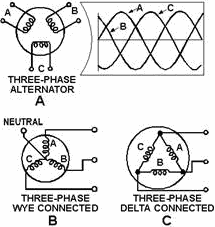
Figure 3-8. - Three-phase alternator connections. Rather than having six leads coming out of the three-phase alternator, the same leads from each phase
may be connected together to form a wye (Y) connection, as shown in figure 3-8, view B. It is called a wye
connection because, without the neutral, the windings appear as the letter Y, in this case sideways or upside
down.
The neutral connection is brought out to a terminal when a single-phase load must be supplied. Single-phase
voltage is available from neutral to A, neutral to B, and neutral to C. In a three-phase, Y-connected
alternator, the total voltage, or line voltage, across any two of the three line leads is the vector sum of the
individual phase voltages. Each line voltage is 1.73 times one of the phase voltages. Because the windings form
only one path for current flow between phases, the line and phase currents are the same (equal). A
three-phase stator can also be connected so that the phases are connected end-to-end; it is now delta connected
(fig. 3-8, view C). (Delta because it looks like the Greek letter delta, D.) In the delta connection, line
voltages are equal to phase voltages, but each line current is equal to 1.73 times the phase current. Both the wye
and the delta connections are used in alternators.
The majority of all alternators in use in the Navy today are three-phase machines. They are much more efficient
than either two-phase or single-phase alternators. Three-Phase Connections The
stator coils of three-phase alternators may be joined together in either wye or delta connections, as shown in
figure 3-9. With these connections only three wires come out of the alternator. This allows convenient connection
to three-phase motors or power distribution transformers. It is necessary to use three-phase transformers or their
electrical equivalent with this type of system.
3-11
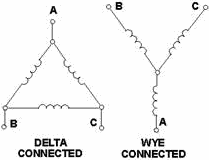
Figure 3-9. - Three-phase alternator or transformer connections. A three-phase transformer may be made up of three, single-phase transformers connected in delta, wye, or
a combination of both. If both the primary and secondary are connected in wye, the transformer is called a
wye-wye. If both windings are connected in delta, the transformer is called a delta-delta. Figure 3-10
shows single-phase transformers connected delta-delta for operation in a three-phase system. You will note that
the transformer windings are not angled to illustrate the typical delta (D) as has been done with alternator
windings. Physically, each transformer in the diagram stands alone. There is no angular relationship between the
windings of the individual transformers. However, if you follow the connections, you will see that they form an
electrical delta. The primary windings, for example, are connected to each other to form a closed loop. Each of
these junctions is fed with a phase voltage from a three-phase alternator. The alternator may be connected either
delta or wye depending on load and voltage requirements, and the design of the system.
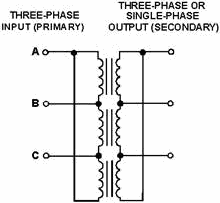
Figure 3-10. - Three single-phase transformers connected delta-delta.
3-12
Figure 3-11 shows three single-phase transformers connected wye-wye. Again, note that the transformer
windings are not angled. Electrically, a Y is formed by the connections. The lower connections of each winding are
shorted together. These form the common point of the wye. The opposite end of each winding is isolated. These ends
form the arms of the wye.
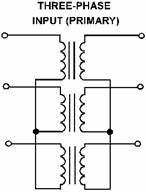
Figure 3-11. - Three single-phase transformers connected wye-wye. The AC power on most ships is distributed by a three-phase, three-wire, 450-volt system. The single-
phase transformers step the voltage down to 117 volts. These transformers are connected delta-delta as in figure
3-10. With a delta-delta configuration, the load may be a three-phase device connected to all phases; or, it may
be a single-phase device connected to only one phase. At this point, it is important to remember that such
a distribution system includes everything between the alternator and the load. Because of the many choices that
three-phase systems provide, care must be taken to ensure that any change of connections does not provide the load
with the wrong voltage or the wrong phase. Q14. In a three-phase alternator, what is the phase
relationship between the individual output voltages? Q15. What are the two methods of connecting the
outputs from a three-phase alternator to the load? Q16. Ships' generators produce 450-volt, three-phase,
AC power; however, most equipment uses 117- volt, single-phase power What transformers and connections are used to
convert 450-volt, three- phase power to 117-volt, single-phase power? Frequency
The output frequency of alternator voltage depends upon the speed of rotation of the rotor and the number of
poles. The faster the speed, the higher the frequency. The lower the speed, the lower the frequency. The more
poles there are on the rotor, the higher the frequency is for a given speed. When a rotor has rotated through an
angle such that two adjacent rotor poles (a north and a south pole) have passed one winding, the voltage induced
in that winding will have varied through one complete cycle. For a given frequency, the more pairs of poles there
are, the lower the speed of rotation. This principle is
3-13
illustrated in figure 3-12; a two-pole generator must rotate at four times the speed of an eight-pole
generator to produce the same frequency of generated voltage. The frequency of any AC generator in hertz (Hz),
which is the number of cycles per second, is related to the number of poles and the speed of rotation, as
expressed by the equation

where P is the number of poles, N is the speed of rotation in revolutions per minute (rpm), and 120 is a
constant to allow for the conversion of minutes to seconds and from poles to pairs of poles. For example, a
2-pole, 3600-rpm alternator has a frequency of 60 Hz; determined as follows:

A 4-pole, 1800-rpm generator also has a frequency of 60 Hz. a 6-pole, 500-rpm generator has a frequency
of

A 12-pole, 4000-rpm generator has a frequency of

Q17. What two factors determine the frequency of the output voltage of an alternator?
Q18. What is the frequency of the output voltage of an alternator with four poles that is rotated at 3600 rpm?
3-14
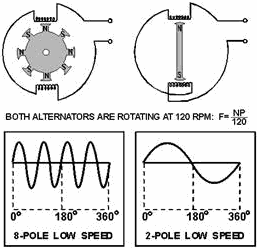
Figure 3-12. - Frequency regulation. Voltage REGULATION As we have seen before, when the load on a generator is
changed, the terminal voltage varies. The amount of variation depends on the design of the generator.
The voltage regulation of an alternator is the change of voltage from full load to no load, expressed as a
percentage of full-load volts, when the speed and DC field current are held constant.

Assume the no-load voltage of an alternator is 250 volts and the full-load voltage is 220 volts. The
percent of regulation is

Remember, the lower the percent of regulation, the better it is in most applications.
Q19. The variation in output voltage as the load changes is referred to as what? How is it expressed?
Principles of AC Voltage CONTROL In an alternator, an alternating voltage is
induced in the armature windings when magnetic fields of alternating polarity are passed across these windings.
The amount of voltage induced in the windings
3-15
depends mainly on three things: (1) the number of conductors in series per winding, (2) the speed
(alternator rpm) at which the magnetic field cuts the winding, and (3) the strength of the magnetic field. Any of
these three factors could be used to control the amount of voltage induced in the alternator windings. The
number of windings, of course, is fixed when the alternator is manufactured. Also, if the output frequency is
required to be of a constant value, then the speed of the rotating field must be held constant. This prevents the use of the alternator rpm as a means of controlling the voltage output. Thus, the only practical method for
obtaining voltage control is to control the strength of the rotating magnetic field. The strength of this
electromagnetic field may be varied by changing the amount of current flowing through the field coil. This is
accomplished by varying the amount of voltage applied across the field cod. Q20. How is output voltage
controlled in practical alternators?
PARALLEL Operation of ALTERNATORS Alternators are connected in parallel to (1)
increase the output capacity of a system beyond that of a single unit, (2) serve as additional reserve power for
expected demands, or (3) permit shutting down one machine and cutting in a standby machine without interrupting
power distribution. When alternators are of sufficient size, and are operating at different frequencies and
terminal voltages, severe damage may result if they are suddenly connected to each other through a common bus. To
avoid this, the machines must be synchronized as closely as possible before connecting them together. This may be
accomplished by connecting one generator to the bus (referred to as bus generator), and then synchronizing the
other (incoming generator) to it before closing the incoming generator's main power contactor. The generators are
synchronized when the following conditions are set: 1. Equal terminal voltages. This is obtained by
adjustment of the incoming generator's field strength. 2. Equal frequency. This is obtained by
adjustment of the incoming generator's prime-mover speed. 3. Phase voltages in proper phase relation.
The procedure for synchronizing generators is not discussed in this chapter. At this point, it is enough for you
to know that the above must be accomplished to prevent damage to the machines. Q21. What generator
characteristics must be considered when alternators are synchronized for parallel operation?
Summary This chapter has presented an introduction to the subject of alternators. You have studied the characteristics
and applications of different types. The following information provides a summary of the chapter for your review.
Magnetic INDUCTION is the process of inducing an emf in a coil whenever the coil is placed in a
magnetic field and motion exists between the coil and the magnetic lines of flux. This is true if either the coil
or the magnetic field moves, as long as the coil is caused to cut across magnetic flux lines.
3-16
The ROTATING ARMATURE-ALTERNATOR is essentially a loop rotating through a stationary
magnetic fealties cutting action of the loop through the magnetic field generates AC in the loop. This AC is
removed from the loop by means of slip rings and applied to an external load.
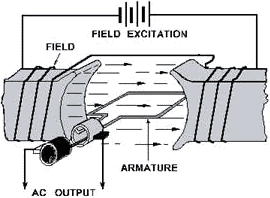 The ROTATING-FIELD ALTERNATOR has a stationary armature and a rotating field. High
voltages can be generated in the armature and applied to the load directly, without the need of slip rings and
brushes. The low DC voltage is applied to the rotor field by means of slip rings, but this does not introduce any
insulation problems.
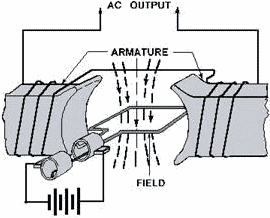
3-17
ROTOR CONSTRUCTION in alternators may be either of two types. The salient-pole rotor
is used in slower speed alternators. The turbine driven-type is wound in a manner to allow high-speed use without
flying apart.
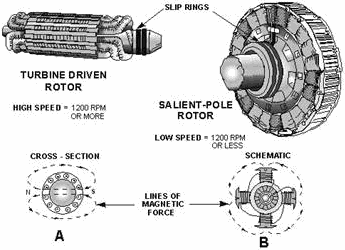
GENERATOR RATINGS are dependent on the amount of current they are capable of providing
at full output voltage; this rating is expressed as the product of the voltage times the current. a 10-volt
alternator capable of supplying 10 amperes of current would be rated at 100 volt-amperes. Larger alternators are
rated in kilovolt-amperes.
EXCITER GENERATORS are small DC generators built into alternators to provide excitation current
to field windings. These DC generators are called exciters. The Single-Phase ALTERNATOR
has an armature that consists of a number of windings placed symmetrically around the stator and connected in
series. The voltages generated in each winding add to produce the total voltage across the two output terminals.
 3-18
A TWO-Phase ALTERNATOR consists of two phases whose windings are so placed around the
stator that the voltages generated in them are 90º out of phase.
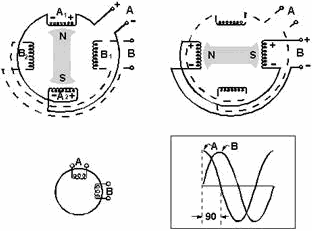
TWO-Phase ALTERNATOR CONNECTIONS may be modified so that the output of a two- phase
alternator is in a three-wire manner, which actually provides three outputs, two induced phase voltages, plus a
vectorial sum voltage.
3-19
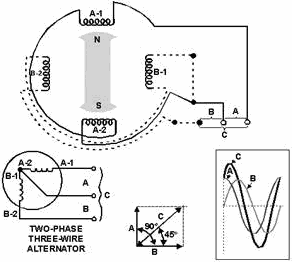 In THREE-Phase ALTERNATORS the windings have voltages generated in them which are 120º
out of phase. Three-phase alternators are most often used to generate AC power.
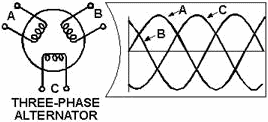 THREE-Phase ALTERNATOR CONNECTIONS may be delta or wye connections depending on the
application. The AC power aboard ship is usually taken from the ship's generators through delta connections, for
the convenience of step-down transformers.
3-20
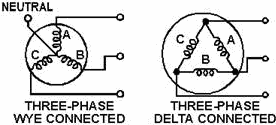 ALTERNATOR Frequency depends upon the speed of rotation and the number of pairs of
rotor poles.
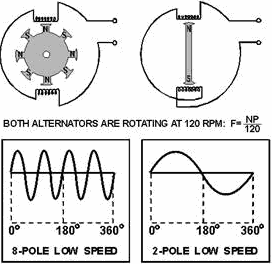
Voltage REGULATION is the change in output voltage of an alternator under varying load
conditions. Voltage CONTROL in alternators is accomplished by varying the current in the
field windings, much as in DC generators.
3-21
Answers to Questions Q1. Through Q21. A1. a conductor and a magnetic field. A2. Armature.
A3. Rotating armature and rotating field. A4. Output voltage is taken directly from the armature
(not through brushes or slip rings). A5. To provide DC current for the rotating field. A6.
Kilovolt-amperes (volt amperes). A7. Steam turbine. A8. Internal combustion engines, water
force and electric motors.
A9. One voltage (one output). A10. In series. A11. Placement of armature coils.
A12. Three. A13. C is 1.414 times greater than a or B. A14. Each phase is displaced 120º
from the other two.
A15. Wye and Delta. A16. Three single-phase, delta-delta, step-down transformers. A17.
Speed of rotation and number of poles. A18. 120 Hz. A19. Voltage regulation. As a
percentage. A20. By varying the voltage applied to the field windings. A21. Output voltage,
frequency, and phase relationships.
3-22
| - |
Matter, Energy,
and Direct Current |
| - |
Alternating Current and Transformers |
| - |
Circuit Protection, Control, and Measurement |
| - |
Electrical Conductors, Wiring Techniques,
and Schematic Reading |
| - |
Generators and Motors |
| - |
Electronic Emission, Tubes, and Power Supplies |
| - |
Solid-State Devices and Power Supplies |
| - |
Amplifiers |
| - |
Wave-Generation and Wave-Shaping Circuits |
| - |
Wave Propagation, Transmission Lines, and
Antennas |
| - |
Microwave Principles |
| - |
Modulation Principles |
| - |
Introduction to Number Systems and Logic Circuits |
| - |
- Introduction to Microelectronics |
| - |
Principles of Synchros, Servos, and Gyros |
| - |
Introduction to Test Equipment |
| - |
Radio-Frequency Communications Principles |
| - |
Radar Principles |
| - |
The Technician's Handbook, Master Glossary |
| - |
Test Methods and Practices |
| - |
Introduction to Digital Computers |
| - |
Magnetic Recording |
| - |
Introduction to Fiber Optics |
| Note: Navy Electricity and Electronics Training
Series (NEETS) content is U.S. Navy property in the public domain. |
|






















